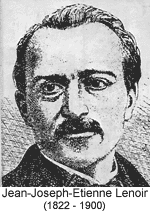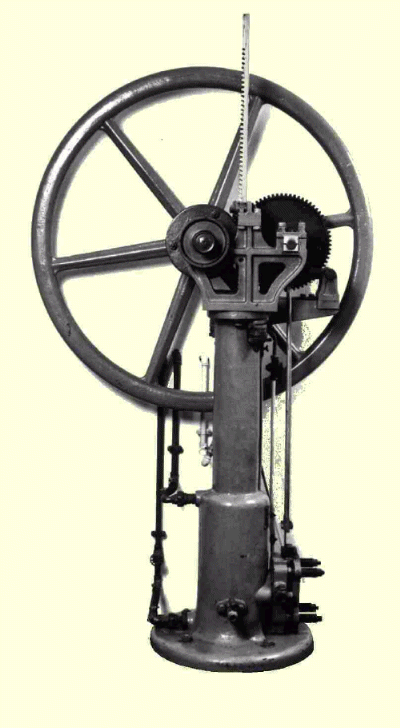Contrary to popular belief, the 4-stroke internal combustion engine was NOT invented by Dr. Otto. Before accusing me of being a heretic, read on..........
The beginnings of the
internal combustion engine can be traced back as far as 1678 when Abbe Hautefeuille apparently invented the gun powder
engine. Further experiments along similar lines by Papin and Huyghens the Dutch scientist resulted in the
conclusion that the gun-powder method was difficult to turn into a working
engine as the explosions were generally too violent to harness.
Blesois and later engineers experimented with other methods
of driving a piston which eventually led to the use of steam. The practical
improvements made by Watt and his successors led to the use of steam power and
it’s domination of the engine world to the exclusion of all other systems for
some time.
The first internal combustion engines were a relatively simple extension of the rotatative steam engine principle in that the basic engine components; the piston running inside a cylinder driving a crank shaft via a connecting rod etc. remained. The development was in ways to provide motive force to the piston and in this respect the process of 'internally combusting' a gaseous mixture the alleviate the requirement for external combustion to generate steam and the paraphernalia that accompanies it was seen as the way forward.
In 1791, John Barber – an
English engineer – proposed and patented a development of the Hautefeuille / Huyghens ideas in which he used the ignition of a mixture
of gas and air as a means of piston propulsion. Further patents followed in
1794 by
Robert Street
“for the production of force from
flammable vapour by means of liquid and air, fire and flame, for the purpose of
setting in motion engines and pumps”. Street’s improvements included the
process of injecting vaporised inflammable liquids into the cylinder containing
the piston. It is quite clear that this had the makings of a useable engine
along the lines of those developed and used today.
Haute
Marne
may be said to equally share the honour of originating the gas engine as he
also had a patent granted in 1799 for the use of gas in the production of
power. He also patented an electrical device, driven from the engine to provide
a source of ignition for the gas (an early form of magneto perhaps). Had he not
been assassinated in 1804, his designs may have resulted in the practical
introduction of the gas engine. Instead this was not destined to occur for a
further 60 years or so.
A number of developments
occurred between 1800 and 1860, the most promising of which was by Wright. He
designed a vertical, double-acting engine designed to drive the crank directly
with the gas in the cylinder being ignited by a heated tube. His design even
included an engine driven governor that varied the gas supplied by a pump. In
this way, the gas supply was kept in line with demand from the engine – quite an advancement at the time. The continued popularity of
steam at this time was probably the reason Wright’s designs were not taken up.
Various developments
continued to take place during the early 19th century, including
ideas for ignition systems. In 1844 John Reynold used
a platinum wire, heated by a battery and in 1850 Stephard developed the idea by replacing the battery by an ‘electro-mechanical’ device
driven from the engine. In 1857 Barsanti and Matteucci described and developed an atmospheric engine, the basis of
which was later adopted by Otto and Langen. This proposal included the use of
electric sparks formed between two platinum points to explode the gas.
Details of Barsanti and Matteucci and their engines can be found here
It was not until 1860 that
the Lenoir engine appeared. Built by Marinoni, it
appeared similar to a horizontal double-acting steam engine. Ignition was by
electric sparks generated by an induction coil and battery. Initially, this
engine was hailed as the greatest of successes. It was reasonably
self-contained, easy to install, required no boiler, and was not terribly
expensive when compared with steam engines of the time and it ran well. Its
downfall was its prodigious use of gas (100 cubic foot per horse-power per
hour!) water and oil.

The Lenoir engine came very
close to success and as such caused a lot of engineers to start showing an
interest, the result being a multitude of developments and patents on different
methods of improving on the theme. M. Hugon introduced an engine in 1862 that offered improved gas consumption (86 cubic
foot per horse-power per hour). This was bought about by virtue of a cooling
system that injected a water mist into the cylinder after combustion,
significantly reducing the exhaust gas temperature in the process.
Further, in 1862, M. Beau de
Rochas obtained a patent that described the conditions that must be met to
obtain truly economical results. It was M. Beau de Rochas that designed the
four-cycle engine that we know and love today. As far as we know, whilst his
designs are now known to have been correct and would have been effective at
producing a truly economical engine, no engine was ever developed to demonstrate
the fact.
The patents of M. Beau de
Rochas expired (when he failed to pay his annuity) and were taken up by Otto
who was the first to realise the Rochas designs in a practical form.
In 1867 a vertical engine
was installed at the International Exhibition in
Paris
. The engine was based on the concepts
of Hautefeuille published 89 years earlier and was built by Otto and Langen.
The engine worked on the atmospheric principle whereby the explosion caused a
vacuum to be formed below the piston thereby ‘sucking’ it downwards. Whilst
this may seem slightly odd when considering current knowledge, it proved to be
vast improvement in terms of fuel consumption. Gas was consumed at the relatively
leisurely rate of 47 cubic foot per horse-power per hour. Approximately 5,000
of these engines were subsequently sold. Developments over a ten-year period
saw gas consumption further reduced to 28 cu. ft. which was enough to provide an overall positive benefit over steam engines and to counter
its critics who maintained that it was very noisy.
It is thought that Dr. Otto
was unaware of the Rochas patent when he introduced a second engine in 1878
that employed the four-cycle principle. Whether or not this was the case, the
four-cycle system became known as the Otto cycle. The new engine was
particularly successful with over 35,000 units being installed. Otto spent much
of the succeeding years in defending his designs and managed to effectively
fend off any potential competition for several years.

An Otto & Langen free piston atmospheric gas engine (1867)
Engineers were forced to
consider other methods of achieving similar results without infringing Otto’s
patents. These included developments of the two-cycle and six-cycle principles.
By the International
Exhibition of 1889 there were no less than fifty-three engines exhibited made
by thirty-one different manufacturers. Of these engines, all but four worked on
the Otto principle. By this time, engines were in existence that
were capable of producing between 200 and 400 horse-power.
It is apparent therefore that Otto successfully developed the four-stroke engine and bought it to prominence but was not responsible for the initial eureka moment as commonly believed.
Bibliography:
Gas and Oil Engines. Their History and Mechanics – From
‘Modern Power Generators’ Vol. 2 1908, The Gas Petrol and Oil engine - Vol. II - Dugald Clerk and numerous internet based publications.
|


